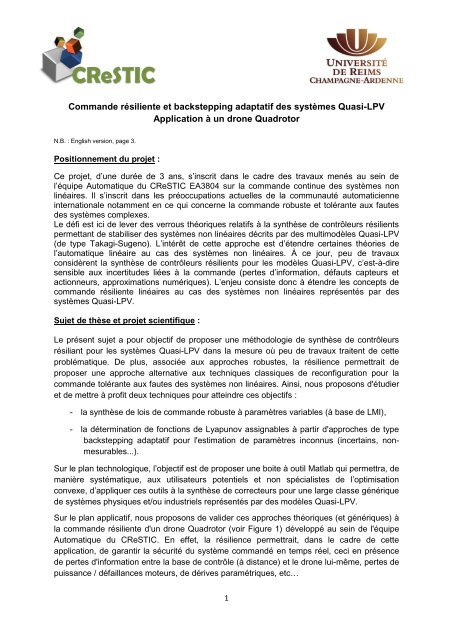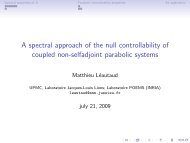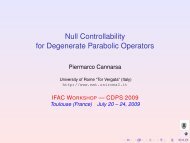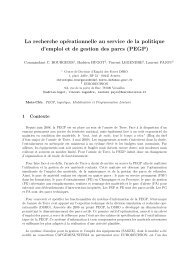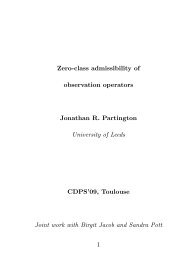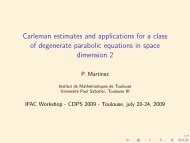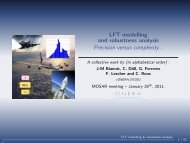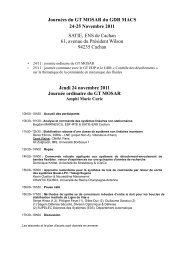Commande résiliente et backstepping adaptatif des systèmes Quasi ...
Commande résiliente et backstepping adaptatif des systèmes Quasi ...
Commande résiliente et backstepping adaptatif des systèmes Quasi ...
You also want an ePaper? Increase the reach of your titles
YUMPU automatically turns print PDFs into web optimized ePapers that Google loves.
<strong>Commande</strong> résiliente <strong>et</strong> <strong>backstepping</strong> <strong>adaptatif</strong> <strong>des</strong> systèmes <strong>Quasi</strong>-LPVApplication à un drone QuadrotorN.B. : English version, page 3.Positionnement du proj<strong>et</strong> :Ce proj<strong>et</strong>, d’une durée de 3 ans, s’inscrit dans le cadre <strong>des</strong> travaux menés au sein del’équipe Automatique du CReSTIC EA3804 sur la commande continue <strong>des</strong> systèmes nonlinéaires. Il s’inscrit dans les préoccupations actuelles de la communauté automaticienneinternationale notamment en ce qui concerne la commande robuste <strong>et</strong> tolérante aux fautes<strong>des</strong> systèmes complexes.Le défi est ici de lever <strong>des</strong> verrous théoriques relatifs à la synthèse de contrôleurs résilientsperm<strong>et</strong>tant de stabiliser <strong>des</strong> systèmes non linéaires décrits par <strong>des</strong> multimodèles <strong>Quasi</strong>-LPV(de type Takagi-Sugeno). L’intérêt de c<strong>et</strong>te approche est d’étendre certaines théories del’automatique linéaire au cas <strong>des</strong> systèmes non linéaires. À ce jour, peu de travauxconsidèrent la synthèse de contrôleurs résilients pour les modèles <strong>Quasi</strong>-LPV, c’est-à-diresensible aux incertitu<strong>des</strong> liées à la commande (pertes d’information, défauts capteurs <strong>et</strong>actionneurs, approximations numériques). L’enjeu consiste donc à étendre les concepts decommande résiliente linéaires au cas <strong>des</strong> systèmes non linéaires représentés par <strong>des</strong>systèmes <strong>Quasi</strong>-LPV.Suj<strong>et</strong> de thèse <strong>et</strong> proj<strong>et</strong> scientifique :Le présent suj<strong>et</strong> a pour objectif de proposer une méthodologie de synthèse de contrôleursrésiliant pour les systèmes <strong>Quasi</strong>-LPV dans la mesure où peu de travaux traitent de c<strong>et</strong>teproblématique. De plus, associée aux approches robustes, la résilience perm<strong>et</strong>trait deproposer une approche alternative aux techniques classiques de reconfiguration pour lacommande tolérante aux fautes <strong>des</strong> systèmes non linéaires. Ainsi, nous proposons d'étudier<strong>et</strong> de m<strong>et</strong>tre à profit deux techniques pour atteindre ces objectifs :- la synthèse de lois de commande robuste à paramètres variables (à base de LMI),- la détermination de fonctions de Lyapunov assignables à partir d'approches de type<strong>backstepping</strong> <strong>adaptatif</strong> pour l'estimation de paramètres inconnus (incertains, nonmesurables...).Sur le plan technologique, l’objectif est de proposer une boite à outil Matlab qui perm<strong>et</strong>tra, demanière systématique, aux utilisateurs potentiels <strong>et</strong> non spécialistes de l’optimisationconvexe, d’appliquer ces outils à la synthèse de correcteurs pour une large classe génériquede systèmes physiques <strong>et</strong>/ou industriels représentés par <strong>des</strong> modèles <strong>Quasi</strong>-LPV.Sur le plan applicatif, nous proposons de valider ces approches théoriques (<strong>et</strong> génériques) àla commande résiliente d'un drone Quadrotor (voir Figure 1) développé au sein de l'équipeAutomatique du CReSTIC. En eff<strong>et</strong>, la résilience perm<strong>et</strong>trait, dans le cadre de c<strong>et</strong>teapplication, de garantir la sécurité du système commandé en temps réel, ceci en présencede pertes d'information entre la base de contrôle (à distance) <strong>et</strong> le drone lui-même, pertes depuissance / défaillances moteurs, de dérives paramétriques, <strong>et</strong>c…1
Figure 1: Drone Quadrotor développé au CReSTICProfil du candidat :Le candidat devra posséder <strong>des</strong> connaissances en Automatique <strong>et</strong>/ou MathématiquesAppliquées ainsi qu’avoir <strong>des</strong> compétences sur la synthèse de lois de commande linéaire <strong>et</strong>non-linéaire. Des connaissances sur les modèles LPV ou <strong>Quasi</strong>-LPV <strong>et</strong>/ou l’élaboration decommande à partir de fonction de Lyapunov assignables pourront constituer un plus.Démarche de candidature :- Le recrutement est effectué sur concours. L’inscription au concours doit êtreeffectuée à partir du site intern<strong>et</strong> de l’école doctorale de Reims (date limite 27/05/13):https://www.adum.fr/as/ed/proposition.pl?site=sts358en cliquant sur le suj<strong>et</strong> « CoRéBaF – <strong>Commande</strong> Résiliente <strong>et</strong> Backstepping <strong>des</strong>systèmes Flous » <strong>et</strong> en suivant la procédure indiquée.- En plus de c<strong>et</strong>te inscription, le dossier constitué d’un CV, d’une l<strong>et</strong>tre de motivationainsi que <strong>des</strong> notes de Master / Ecole d’ingénieurs sont à envoyer obligatoirement àkevin.guelton@univ-reims.fr <strong>et</strong> laurent.arcese@univ-reims.fr.Financement :Bourse Ministère ou Bourse Région (pas de distinction entre supports ministériels <strong>et</strong> régionau niveau de l’URCA, environ 1400€ n<strong>et</strong>/mois)Laboratoire d’accueil <strong>et</strong> contacts :Kevin Guelton, kevin.guelton@univ-reims.fr, 03 26 91 32 61Laurent Arcese, laurent.arcese@univ-reims.fr, 03 26 91 31 93CReSTICUFR Sciences Exactes <strong>et</strong> NaturellesMoulin de la Housse - BP103951687 Reims Cedex 22
Resilient and adaptive <strong>backstepping</strong> control of <strong>Quasi</strong>-LPV systemsApplication to a quadrotor UAVThis project of three years takes place within the framework of the work in the automaticteam from the CReSTIC on continuous control of nonlinear systems. The development ofrobust and fault-tolerant control is currently an active research area since the systemsbecome more and more complex and difficult to model precisely.The goal of this project is to propose innovative theor<strong>et</strong>ical solutions related to the synthesisof resilient controllers to stabilize non-linear systems <strong>des</strong>cribed by <strong>Quasi</strong>-LPV multi-model(Takagi-Sugeno). The advantage of this approach is to extend some theories of linear controlto the control of non-linear system. To date, few techniques devoted to the synthesis ofresilient controllers for <strong>Quasi</strong>-LPV systems have been proposed, that is to say, sensitive touncertainties on the control (information loss, sensor fault and actuators, numericalapproximations). The challenge is therefore to extend the concepts of linear resilientcontrollers to the case of non-linear systems <strong>des</strong>cribed by <strong>Quasi</strong>-LPV systems.In addition, combined with robust approaches, resilient control would propose an alternativeapproach to conventional techniques for reconfiguration of the fault-tolerant control of nonlinearsystems. Thus, we propose to study and to use two techniques to achieve these goals:- synthesis of robust control laws (based on LMI),- finding Lyapunov functions (from an adaptive <strong>backstepping</strong> approach) for estimatingunknown param<strong>et</strong>ers.From a technical point of view, the objective is to provide a Matlab toolbox that will enable, ina systematic way, for potential users and non-specialists of convex optimization to applythese tools to the synthesis of control laws for a wide generic class of physical and/orindustrial systems <strong>des</strong>cribed by <strong>Quasi</strong>-LPV models.From an application point of view, we propose to validate these theor<strong>et</strong>ical approaches to thecontrol of a quadrotor UAV developed in the automatic team. Indeed, resilience is expectedto ensure the saf<strong>et</strong>y of the system in real time, in the presence of loss of information b<strong>et</strong>weenthe base control and the drone itself, power loss, engine failures, param<strong>et</strong>ric drifts, <strong>et</strong>c…Figure 1: Quadrotor UAV3
Candidate profile:The candidate will have knowledge in automatic and/or applied mathematics as well as skillson the synthesis of linear and non-linear control laws. Knowledge of LPV or <strong>Quasi</strong>-LPVcontrol and/or development control based on Lyapunov function will be appreciated.Procedure to follow:- The recruitment is based on the results of an entrance examination. Application mustbe done from the website (deadline 27/05/13):https://www.adum.fr/as/ed/proposition.pl?site=sts358by clicking on the topic « CoRéBaF – <strong>Commande</strong> Résiliente <strong>et</strong> Backstepping <strong>des</strong>systèmes Flous ».- In addition, the whole application file, including a Curriculum Vitae, a cover l<strong>et</strong>ter andthe results obtained during the last school year (or two years) must be sent tokevin.guelton@univ-reims.fr and laurent.arcese@univ-reims.fr.Source of funding:Ministry or Region (around 1400€ n<strong>et</strong>/month)Contacts:Kevin Guelton, kevin.guelton@univ-reims.fr, +33 3 26 91 32 61Laurent Arcese, laurent.arcese@univ-reims.fr, +33 3 26 91 31 93CReSTICUFR Sciences Exactes <strong>et</strong> NaturellesMoulin de la Housse - BP103951687 Reims Cedex 2, France (F)4


